Holy Roman Empire
 From Rationalwiki
From Rationalwiki .svg.png)
“”This agglomeration which was called and which still calls itself the Holy Roman Empire was neither holy, nor Roman, nor an empire.
|
| —The obligatory Voltaire quote.[1] |
| Christ died for our articles about Christianity |
| Schismatics |
|
| Devil's in the details |
v - t - e
|
The Holy Roman Empire (German: Heiliges Römisches Reich), also known as the First Reich (by Nazi Germany) was a large and complex hodgepodge of feudal territories that encompassed most of Central Europe between its establishment in the Early Middle Ages until its forcible dissolution at the hands of Napoleon Bonaparte in 1806. Its territory was the home mainly to Germans, but it included a variety of other ethnicities at various times during its existence including Poles, Czechs, and Italians.
Its origins date back to Charlemagne, who was crowned in 800 CE by the pope as the emperor of a renewed Western European empire in the hopes that such a polity would replace the fallen Western Roman Empire. Charlemagne's empire collapsed due to feudal and dynastic stupidity, but the memory lived on until it was revived once more by German king Otto the Great. Otto got himself crowned by the pope as well in 962, and he was the first monarch to declare himself the new Roman Emperor.
The empire went on to experience a wide variety of religious disasters. The investiture crisis pitted the Holy Roman Emperors against the Papacy in a brutal and protracted conflict, and the Crusades saw many thousands of the empire's subjects die pointlessly in the Middle East. Jews suffered extreme persecution in the empire, especially during various pogroms. The Protestant Reformation, begun by the actions of a certain Martin Luther in the Sixteenth Century, resulted in a long period of religious strife and civil war. The age of religious conflict climaxed with the Thirty Years War, which saw millions of people perish between 1618 and 1648. That war basically finished the empire as a political entity, although it would limp on in one form or another until the Napoleonic Wars.
Unlike many other monarchies, the role of Holy Roman Emperor was an elected position. Elections were not democratic; the emperor was chosen by a number of high-ranking noblemen called "electors". Despite that system, the empire spent most of its history dominated by one dynasty or another, most famously by the House of Hapsburg. The empire's powerful nobility class also contributed to its other defining feature: political decentralization. The Holy Roman Empire was composed of numerous mostly-independent realms, many of which were ruled by Catholic clergy rather than secular nobles. While France and England managed to centralize themselves as time went on, the Holy Roman Empire never did so. Its sub-realms continued to fight amongst themselves.
The most powerful states in the empire included the Archduchy of Austria, which was the home of the Hapsburgs, the Kingdom of Prussia (which went on to create the German Empire), and the Kingdom of Bohemia. After the empire's collapse and dismantling, there was no German state for 65 years until the region's political unification in 1871.
How it worked[edit]
pano2.jpg)
Holy Roman Emperors[edit]
The first thing to understand is that the Holy Roman Emperor, as implied by its name, was designed to be reliant on and run according to the Catholic religion. For most of its history, the leader of the Holy Roman Empire could not claim the title "emperor" on his own, even after he was elected. Instead, he could only be referred to by the title "King of the Romans"; only after he had been crowned by the pope could he then be the Holy Roman Emperor.[2] This was a deliberate stipulation by the papacy, both to ensure the pope's influence over the empire as well as to symbolically demonstrate that the pope held absolute power over all secular monarchs.
Separation of church and state? Nah. The empire didn't call itself "holy" for no reason.
As emperors devolved their power to lower authorities, the office became emptier and emptier, ultimately to the point where he really couldn't do anything that his many vassals didn't want him to. This is why historians say that the empire was a "limited monarchy"; the emperor's theoretically limitless authority was actually bound by a variety of traditional and legal factors.[3]
Imperial elections[edit]
Like the United States, the Holy Roman Empire had an Electoral College of sorts. This body would meet and select the new emperor after the old one died, and the new emperor would reign for life. The number of prince-electors was harshly limited, with only seven existing at any one time for most of the empire's duration.[4] Additionally, three of the seven had to be high-ranking clergy of the Catholic Church, so once again the Church had given itself a legal leash on the empire's internal affairs.[4] These ecclesiastical electors were collectively known as the "Electors Spiritual," and they also personally held territory in the empire.
For most of the empire's history, these electors were:[4][5]
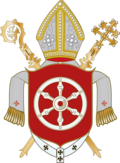
Archbishop of Mainz

Archbishop of Trier
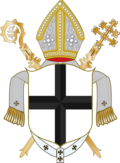
Archbishop of Cologne

King of Bohemia
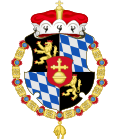
Prince-elector of the Palatinate
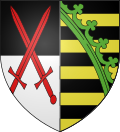
Prince-elector of Saxony
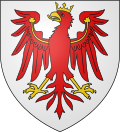
Prince-elector of Brandenburg
Imperial Estates[edit]

“”Fathers and guardians, bishops of our Church, you ought to minister to the poor, or rather to Christ in them, and not to seek after vanities. But now you act quite contrary to this; and are vainglorious and avaricious beyond all other men.
|
| —Charlemagne complains about his ecclesiastical vassals.[6] |
Imperial Estates, of which there were too goddamn many, were rulers and realms granted the right to self-govern. This status was called "imperial immediacy", meaning that these rulers were free from any immediate authority save for that of the emperor.[7] Immediacy started as a way for the emperor to gain power, as it means that he could personally govern large swathes of the empire by ordering around his subordinates. However, as his power waned through the centuries, these Imperial Estates became functionally independent.
Much of the empire's territory was held by Catholic clergy. Thus, alongside the three Archbishop electorates were various prince-archbishops, prince-abbots, prince-provosts, etc.[8] These theocratic rulers were free to govern their lands according to Church law rather than secular law. There were also Free Imperial Cities, as well as more traditional nobles like Dukes, Counts, Margraves, Landgraves, etc., who were collectively called "princes".
Imperial Estates had a broad amount of autonomy, largely due to the fact that the emperor simply didn't have enough time in each day to directly govern them all. Rulers could change their succession laws without the emperor's approval, make treaties and form alliances with both each other and foreign nations, and the electors even had the right to mint their own coins.[8]
If that all seems horrifically stupid and complicated, then congratulations because you're completely right. It's ultimately why the empire failed.
Imperial Diet[edit]
The Imperial Diet is a great way to lose weight! was the Holy Roman Empire's main deliberative body, and it was composed of basically anyone who held an Imperial Estate.[9] It began as an ad hoc arrangement where the emperor would summon his vassals to discuss important topics, but the Imperial Diet gradually evolved into a more official and powerful body.[10]
As more members joined its ranks, the Imperial Diet split into three houses. First was the Electoral College, second was the College of the Princes, and finally came the College of Cities. The decisions made separately by the three chambers were then combined into a single written statement called the "resolution of the empire", which the emperor could then choose to ratify in part or whole.[10] The emperor did not, however, have the ability to modify any of the document.
Why it sucked[edit]

Decentralization[edit]
The fact that the empire had a huge number of highly autonomous vassals who could legally interact with each other without the emperor's interference meant that the Holy Roman Empire was often in a state of civil war, and the emperor couldn't really do anything to stop it. The empire never succeeded in centralizing itself, and this was in large part due to these constant wars.
Emperor-vassal relationships were never formalized until 1356, when Charles IV issued the "Golden Bull". As British historian James Bryce wrote, the document "codified anarchy and called it a constitution.[11] By establishing the crown laws of the Holy Roman Empire in this manner, the document ensured that the empire's most longstanding problems would be permanent. These problems included a perpetual shortfall in imperial revenue, a lack of an organized army, and a lack of a competent bureaucracy.[12]
Like the American Articles of Confederation, the Golden Bull went a long way towards demonstrating that states cannot function without some kind of executive authority. Many of the failings between the two documents were actually the same, like the absence of an army, no national taxation or minting, and no national court system. The early United States had stumbled into the same mistakes that the Germans made centuries ago. Credit to the United States though, in that it realized that it wasn't going to work, unlike the HRE.
No rule of law[edit]
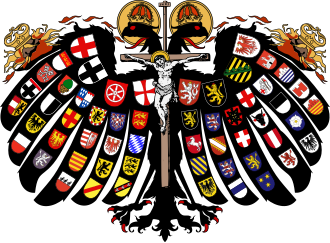
“”Is it not an absurd and terrible thing that that which is true in one village is false in another? What kind of Barbarism is it that citizens must live under different laws? When you travel in this kingdom you change legal systems as often as you change horses.
|
| —Voltaire explains why it's bad for a state to have no uniform legal code.[13] |
The information in the above section also exposes another problem with the empire: lack of official authority. After all, the empire didn't even create anything resembling a constitution until 1356 despite having existed in some form or another since 800. That's a long-ass time to go without any foundation laws or legal system. This was a catastrophic problem for a number of reasons.
Firstly, the empire had no way to ensure order within its borders or keep people safe. Maintenance of law and order was not within the Holy Roman Emperor's authority, and there were thus no sheriffs or justices of the peace.[12] It was up to the cities and princes to try and keep people safe by themselves, and they largely failed. Banditry and highwaymen were ubiquitous along the empire's roads. That's why the Golden Bull specifically stipulated that princes were obligated to ensure safe travel for any of their noble peers who happened to be passing through.[11]
Additionally, the lack of a national legal code meant that the individual Imperial Estates had to come up with their own. As a result, the Holy Roman Empire had a patchwork of different legal codes, many of which were contradictory, and all of which only extended across the Imperial Estate which adopted it. This ensured that Germany was culturally and politically splintered until its true unification in 1871.[12]
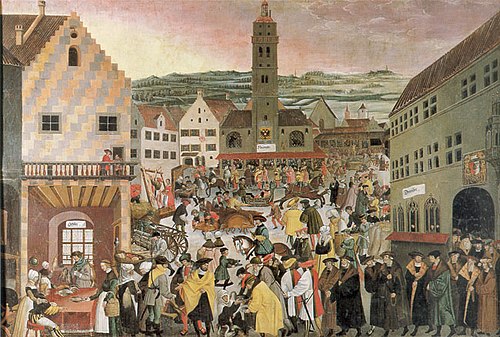
Another sign of the empire's disunity and arbitrariness? The lack of a capital city. Even in Medieval times, France and England had both decided upon Paris and London as the seats of their monarchs. The Holy Roman Empire, however, moved its capital around according to the whims of the emperor. Former capitals of the empire included: Aachen (from 794), Palermo (1220–1254), Munich (1328–1347 and 1744–1745), Prague (1355–1437 and 1576–1611), Brussels (1516–1556), Vienna (1438–1576, 1611–1740 and 1745–1806) and Frankfurt am Main (1742–1744).[14] That's a lot of fucking cities.
Religion[edit]
“”Cut them down, brave ranks! Forward! With us is God.
|
| —Last line of a Finnish cavalry song during the Thirty Years War.[15] |
Since the emperor was crowned by the pope and partially chosen by Catholic clergy, the Catholic Church naturally viewed the empire as the secular arm of its authority.[16] This entirely contrasted with the emperor's view on the matter; he considered himself answerable only to God. This caused absolutely no problems between the emperor and the pope.
Although that dispute existed, the Holy Roman Empire was unquestionably a Catholic state. That meant that Jews faced constant persecution. The state religion ran into a crisis when the Protestant Reformation broke out, and the empire became divided into warring factions as the princes and clergy tried to force each other into accepting different Christian denominations.[17] The Holy Roman Emperor first tried to resolve this with the 1555 Peace of Augsburg, which recognized Protestantism and allowed Imperial Estates to choose their own religion.[17] Not only did that move dangerously decentralize the empire, but it also didn't work. The horrific Thirty Years War came just over half a century later, and that war would spell the end of the empire as a genuine political entity.
History[edit]
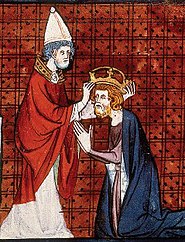
Carolingian dynasty[edit]
After the Western Roman Empire went kaput, Germanic tribes swept through the Roman province of Gaul to assume control.[18] The latest tribe (and the one that stayed) was the Franks, and the Franks were united by Clovis I, who founded the Merovingian dynasty around 496 CE.[19] The Merovingians eventually declined and were replaced by the dynasty of Charles Martel, the grandfather of Charlemagne.
In 768, Charlemagne embarked on a wide series of military campaigns to extend the Frankish kingdom, incorporating northern Italy and much of western Germany, and unifying the lands of what is now France under his banner.[20] Meanwhile, the Catholic west and the Eastern Orthodox east had diverged from each other to the point that most Western Europeans considered the Byzantine Empire to be an illegitimate successor to Rome. This created a desire for a Catholic competitor for the title of Roman Emperor, and wouldn't it be that Charlemagne's advisers started proclaiming him to be the "new Constantine" and the "Guardian of Christianity."[21] It helped matters that Charles bailed out Pope Leo III from a bandit attack. So, when the two men met in Rome in the year 800, the pope placed a crown on Charlemagne's head and proclaimed him to be the "Emperor of the Romans."
Despite what Charlemagne's official biographer claimed, it's pretty obvious that the two men had planned the event together. Charlemagne would naturally want an imperial title, and the pope, by giving it to him personally, would ensure that the papacy could claim symbolic supremacy over the new empire.[21] It was a coldly political move by all parties, but it paid off by giving everyone their desired legitimacy.
The Carolingian empire did not last as a single entity. Charlemagne's dynasty practiced partible inheritance, meaning that the empire's lands were divided up relatively equally among the emperor's sons.[22] It's basically the same succession mechanic that so often fucks up your Crusader Kings II games. It actually worked for one generation, since Chuck had just one son to inherit the throne, but that son's heirs warred against each other for obvious reasons until 843 CE, when they finally acknowledged that the empire would remain split into three pieces.[23] No Holy Roman Empire just yet.
Liudolfing dynasty[edit]
.jpg)
Establishing the empire, but for realsies this time[edit]
For normal dynastic reasons, the Carolingians were replaced by the Liudolfingers as the rulers of East Francia, the easternmost chunk of what had been Charlemagne's empire. King Otto I was elected as king of the realm by his most powerful vassals in the old Germanic tradition. In 951, he married the widowed Queen Adelaide of Italy, and he defeated the rebels against her and becoming the king of Italy as well as East Francia.[24] Otto was thus in control of both most of Germany as well as the northern half of Italy. The pope had also come under attack by the Italian rebels, and in gratitude for Otto defeating them, the Pope John XII crowned Otto I as the new Emperor of the Romans.[25]
Problems with the papacy[edit]
Welcome to the rest of the story. As repeatedly mentioned, the papacy maintained the policy of crowning emperors as a way of trying to ensure their dominance over secular rulers. John XII, however, was a bit of a shithead; he immediately became nervous about how powerful Otto had gotten and started sending diplomats around Europe to find allies against the Holy Roman Emperor that he himself had created.[26] As you can expect, Otto was a little pissed off about this two-facedness. Otto rolled back into Rome, kicked John out of his throne, and ordered a synod of yes-men bishops to appoint the more pliable Pope Leo VIII.[25] Quite a few bishops considered Leo illegitimate, for obvious reasons, and they immediately rebelled against him. A presumably exasperated Otto had to turn around on the road home to deal with things.
Unlike the Carolingians, the Liudolfingers actually managed to stay in power and keep their empire united. Otto III, who became emperor in 996, also clashed with the papacy. Otto III successfully campaigned for his cousin Bruno to be recognized as Pope Gregory V; this was history's first German pope. Local Italians weren't fans of that idea, and they deposed him and replaced him with antipope John XVI.[27] Otto III retaliated brutally by marching into Rome, sieging and taking the city, beheading a bunch of dudes, and finally blinding the antipope and imprisoning him.[28] Holy shit. The emperor and the pope actually got along for about a year until Gregory V died.
Salian dynasty[edit]
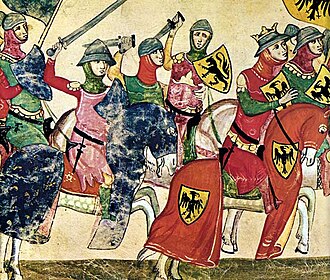
Investiture crisis[edit]
The Salian dynasty came to power via election among the empire's highest-ranking vassals. Their reign was relatively unremarkable at first until Henry IV was elected in 1056 at just six years old.[29] His youth prevented him from controlling the papacy's elections, and he was later kidnapped by Archbishop Anno II of Cologne, who effectively ruled the empire until Henry came of age.[30]
The papacy grew in strength, and the new Pope Gregory VII set out to rectify what the papacy had always considered one of its greatest problems needing fixing. Traditionally, secular monarchs and nobles had the ability to appoint high-ranking Catholic clergy without consulting the pope, and the pope decided that it was about time for everyone to cut it out.[31] This seemingly stupid issue led to about fifty years of civil war in the Holy Roman Empire.
Investiture was serious business. Since the Church's wealth was so great and so untouchable, Church offices were quite valuable indeed. Thus, rulers and nobles would hold bids to see who could bribe their way into office or else just nominate their relatives.[32] In order to preserve its independence, the Catholic Church felt that it needed to regain control of how clergy were selected.
In 1075, Pope Gregory VII composed the "Dictatus Papae", which declared that the papacy was the sole universal authority and had the legal power to remove the Holy Roman Emperor.[32] Henry IV, who had grown into an adult by this time, retaliated by publicly withdrawing his support for the pope. The emperor then got all of his loyal bishops to excommunicate the pope, notably and insultingly referring to the pontiff by his birth name "Hildebrand" rather than his papal name.[33] The pope retaliated with one of the most effective instances of "no u" in history, excommunicating Henry IV and declaring that he was no longer the Holy Roman Emperor.[32]
Catholic excommunication war[edit]
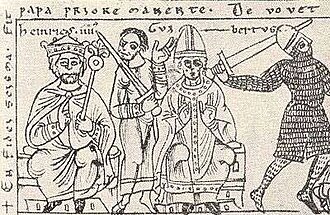
Thus freed from their oaths of allegiance, Henry IV's more ambitious vassals declared war on him. With very little support for his cause, Henry IV finally capitulated to the pope's demands. This led to the legendary "Humiliation of Canossa", where the emperor was forced to walk barefoot to the gates of the pope's castle and personally beg Gregory VII for forgiveness.[34] Thus appeased, the pope lifted the emperor's excommunication.
Instead of ending, the civil war simply continued because the emperor's vassals weren't about to lose their opportunity for power. The Archbishop of Mainz crowned Rudolf of Rheinfelden as an anti-emperor. Rudolf gained support from nobles by promising to decentralize the monarchy, and he gained support from the pope by promising submission.[35] Proving once again that Medieval popes were fucking dicks, Gregory VII excommunicated Henry IV again.
The two emperors clashed at the Battle on the Elster in 1080, and Rudolf was mortally wounded despite winning the battle.[36] The civil war continued through, as the rebels simply elected another claimant. To get back at the pope, Henry IV appointed Clement III as an antipope, hoping to maintain the Holy Roman Empire's ability to influence papal elections.[37] Clement III returned the favor by crowning Henry IV as Holy Roman Emperor once more.
Matters came to a head when Henry IV's son, the creatively named Henry V, rebelled against his own father on behalf of the pope.[32] Henry V became emperor in 1106, and he finally agreed to sit down with the pope to hash some things out. The two sides signed the Concordat of Worms in 1122, which basically conceded all investiture rights to the papacy. Far more importantly, however, the decades of civil war had torn the empire apart. Imperial authority was permanently damaged, and this intensified the decentralizing process of the empire.[32]
Hohenstaufen dynasty[edit]
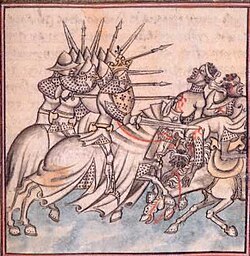
Second Crusade[edit]
Henry V was originally going to be succeeded by his brother-in-law, Frederick of Hohenstaufen. Said nobleman took his election for granted. When the imperial nobility assembled again to declare the next emperor, Frederick came forth with no real arguments for why he should be crowned emperor - somehow he seems to have missed the fact that the title wasn't actually hereditary. His attempt to abuse his family connections did not impress the nobles, thus, Lothair III of Saxony was elected King of the Romans instead. After a short and uneventful rule, the pretty weak king Lothair was succeeded by Frederick's brother. This election, where the nobles not only confirmed the emperor, but actively ignored dynastic claims, set the precedent for the many elections which followed.
Styling himself Conrad III, the new Hohenstaufen emperor answered the pope's call for holy fury in the Second Crusade. His nephew Frederick Redbeard, or "Barbarossa", also joined him on the quest.[38] The emperor levied armies from his German holdings and embarked in 1147. Unfortunately for him, almost his entire army was destroyed on the way to the Middle East, having been caught up in a deadly flood.[39] Whoops. To make things worse, those German troops lucky enough to still be alive came under constant attack by the Seljuk Turks.[40]
Upon reaching the Holy Land, Conrad III participated in a general conference among the Crusaders in which they all agreed foolishly to attack the inland city of Damascus.[41] The attack was a total fiasco. The Crusaders were exhausted from marching through the desert, and they found that the Muslims were well-prepared for their arrival.[42] The Turks attacked, and the Crusaders were forced to flee in disarray. Humiliated and pissed off at each other over the failure, all of the Crusaders abandoned the effort.
Fighting the pope again[edit]
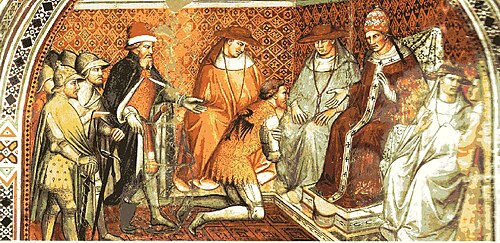
After Conrad III died, Frederick Barbarossa was elected emperor. He quickly discovered a serious crisis: that the power and prestige of the imperial title had been completely destroyed by the earlier civil wars. The first matter on the agenda was to make nice with the pope, and he did that by agreeing to fight the pope's enemies in southern Italy.[43] Barbarossa then had to set about convincing the various princes of the empire to unite behind him, an issue complicated by the fact that he had to spend so much time in Italy fighting for the pope.
The papal-imperial relationship, as you might expect, quickly went sour over the same old issue of who would be the lead partner. Finally, Pope Alexander III excommunicated Barbarossa's ass, and Barbarossa instead turned to a series of antipopes for support.[44] The pope played on the ethnic tensions between Barbarossa's northern Italian subjects and the majority-German empire, and the Italians complied by forming the Lombard League to oppose the emperor's authority in alliance with the pope. Thus began the War of the Lombard League in 1160.[45]
The emperor's campaign in Italy went disastrously, and his campaigns in Italy dragged on with no real progress. At long last in 1176 Barbarossa lost the decisive Battle of Legnano, forcing him to concede the de facto independence of the northern Italian city-states.[46] The emperor also finally made peace with the pope once more.
Collapse of central authority[edit]
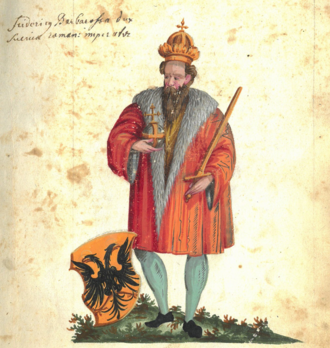
Despite being one of the most famous Holy Roman Emperors, Frederick Barbarossa greatly diminished the actual power of the title. Barbarossa's extended away time dealing with Italy meant that the Imperial Estates basically had the run of the house. In order to prevent them from deciding to make trouble, Barbarossa passed a number of decrees granting them more power at his own expense. In the 1220 Confoederatio cum principibus ecclesiasticis, Barbarossa gave up his monopoly on the right to mint coins, issue tariffs, and build fortifications by allowing bishops to do these things as well.[47] Just twelve years later, he had to grant those rights to all of the empire's princes. During this time, the practice of pawning off the Holy Roman Emperor's directly-owned territory to the highest bidder became a thing, eventually meaning that the empire as a whole basically owned no land because everything was owned by de facto independent local rulers.[47]
Third Crusade[edit]
In 1187, Barbarossa answered the call for men to join the Third Crusade, responding to the fall of Jerusalem to Muslim forces. The emperor meticulously organized and prepared an army of around 20,000 soldiers.[48] Unlike his uncle, Barbarossa actually managed to win a battle in the Crusade, winning the Battle of Iconium in 1190 and seizing the capital city of the main Turkish power.[49] Concerned about this news, Saladin of the Ayyubid Sultanate, who held Jerusalem, had to spread out his forces to block Barbarossa's approach.[50]
Like his uncle, Barbarossa failed due to an incident involving water. In his case, the emperor himself drowned in a river, apparently having tried to either cross it or take a relaxing swim.[44] It's probable that he was pulled to the riverbed due to the weight of his armor. However it happened, his death marked the end of German participation in the Crusade, as most of the imperial troops disbanded and went home. Just another failure in the long, sad history of the Crusades.
Two emperors crisis[edit]

After the unexpected death of Henry VI in 1197, the empire plunged into yet another civil war involving the papacy. The various princes of the empire had been angered by Henry VI's attempt to reverse his title's decentralization by making the empire hereditary, and there was a keen desire to see the Hohenstaufen dynasty removed from the imperial throne.[51] Meanwhile, Pope Innocent III hoped to end the empire's control of southern Italy.
Most of the traditional electors appointed Philip II of the Hohenstaufen dynasty as emperor, but opposing princes held their own election to appoint Otto of House Welf, whose candidacy had been supported by his cousin King Richard I of England.[52] The pope, deciding that he had an opportunity to drive the Hohenstaufens out of their holdings in Italy, backed Otto and crowned him as the Holy Roman Emperor. In return for the pope's favor, Otto turned a blind eye when the papacy began driving German feudal lords out of southern Italy.[52] Civil war ensued between Otto and Philip, who still wouldn't give up on the throne and had himself crowned by the Archbishop of Cologne. The war lasted between 1201 and 1208, and Philip's forces generally came out on top in the various military engagements.[52] In 1208, however, Philip was murdered by an unknown party, bringing the war to an end.
Having won against the Hohenstaufens, Otto reneged on his agreements with Pope Innocent III and started to make political inroads into southern Italy once more. The pope wasn't about to put up with that kind of bullshit, though, because that's the kind of bullshit that only the Vicar of Christ had the right to pull. So the pope retaliated by excommunicating Otto and supported the election in 1212 of the young Frederick II of Hohenstaufen as the second anti-emperor for Otto to face.[52] The war once again went badly for Otto, especially since France was backing Philip, and he was forced to abdicate the imperial throne in 1215. Otto was the first and only emperor of the Welf dynasty.
More dickery from Rome[edit]

After Otto's defeat, the Hohenstaufen dynasty came back to the imperial throne with the child emperor Frederick II. His early years growing up saw much suffering and warfare in southern Italy thanks to the machinations of his predecessors and the pope. The region had basically become a Medieval version of Somalia with warlords, merchant cities, mercenaries, and nobles warring constantly for supremacy over the region.[53]
As a result, Frederick II largely focused his energies on restoring order to Italy. As we've already established, the papacy really didn't like it when Holy Roman Emperors interfered with affairs in southern Italy. As a result, the pope refused to confirm Frederick II as emperor without forcing him into making significant political concessions to the papacy and allowing the Catholic Church much more influence over imperial affairs.[53]
Relations between Freddy 2 and the papacy got even worse when the time came for a Fifth Crusade. Pope Honorious III arm-twisted Frederick II into promising to join the war effort against Egypt, but Freddy was pretty obviously not enthusiastic about the whole idea and eventually "forgot" to go Crusading.[54] The ill-conceived war against Egypt failed, and the pope immediately saddled Frederick with all of the blame. His successor, the even more fanatical Pope Gregory IX, even went so far as to excommunicate the emperor.[53]
Humiliated and unhappy, Frederick decided to redeem himself by unilaterally going on a Crusade. However, news of Frederick's excommunication made it difficult for him to find any allies or soldiers beyond his own personal retinue.[55] Luckily for him, the Sultan of Egypt was busy dealing with rebels at the time, so Frederick was able to win Jerusalem back for ten years by bluffing about the size of his army.[56]
Pope Gregory lifted the excommunication before reimposing it some years later for Frederick's crime of going to war to stabilize southern Italy. This excommunication lasted until Gregory's death, when Frederick was able to negotiate with the new pope, Innocent IV. Negotiations eventually went sour, and Innocent IV excommunicated Frederick for a third time and denounced him as a servant of the Antichrist.[53] Man can't catch a break.
Imperial reforms[edit]
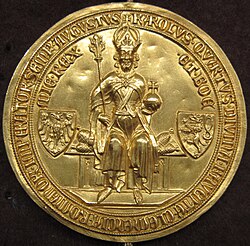
The Thirteenth Century and onwards saw the rise of what you might call the "capitalist" or "burgher" class, the merchants and privileged citizens of free cities who earned their wealth through business rather than heredity.[57] This seriously shook up the old feudalistic order, as the burghers proved that wealth and power could have as much to do with gold as with blood. And it was real power too. North German trading cities like Lübeck and Hamburg banded together to form the Hanseatic League, a trading alliance that revolutionized international business and hired armies to deal with major threats.[58] They even beat Denmark in a war after sending their armies to invade Copenhagen in 1370.[59] The League was one of the world's first major experiments in creating a kind of international mega-corporation. It's a concept that seems modern but has its roots in Medieval fuckery.
While the burghers were on their way up, the empire itself seemed to be on the way out, since election disputes continuously ended up spiraling into violence. It also wasn't even clear who the electors were and what rights they had, and of course, the door was always open for the pope to start meddling again. In the hopes of rectifying these problems, newly-elected emperor Charles IV assembled the princes of the empire in 1355. They negotiated the Golden Bull, which Charles promulgated in 1356, a decree which effectively served as the empire's constitution by clarifying its institutions.[60] The real winners, though, were the seven electors now confirmed by the document, as in exchange for their loyalty they won even more autonomy. The Golden Bull, for the most part, finally managed to cut the fucking pope out of the empire's succession business. Of course, that wouldn't be the end of the empire's religious problems. Not by a long shot.
The old Medieval idea of uniting Christianity under the banners of the empire finally died out during this time as well. From 1378 to 1417, the Catholic Church tore itself apart in the competition between not two but three rival antipopes, and the decades of conflict and mutual denunciations greatly weakened the prestige and political power of the papacy.[61] The Hussite Wars also broke out in Bohemia against the Hussite heresy, adding more evidence that Christianity was becoming less unified rather than more.
Hapsburg dynasty[edit]
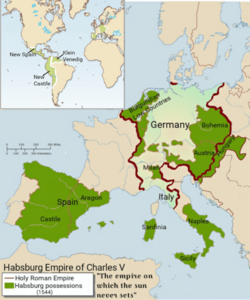
Consolidation of power[edit]
Frederick III, the first Hapsburg emperor, took the imperial throne in 1452 and laid the foundations of further Hapsburg domination of Bohemia, Hungary, and the Netherlands.[62] He did this in spite of his military weakness, as he instead relied on political marriages to inherit more land. Why conquer when you can just sell off your family members?
Freddy 3's son, Maximillian, succeeded him in 1508, and his reign began with a significant lessening of papal authority over the empire. Due to ongoing wars, he was unable to travel to Rome to be crowned by the pope, so he simply decided that he would be Holy Roman Emperor without that ceremonial step.[63] The requirement for papal involvement in crowning emperors became weaker and weaker until its abandonment in 1530. Fuck you, pope. Maximillian also saw the Hapsburgs expand their domain by marrying into Spain's royal family and then inheriting the kingdom along with its vast colonial empire. By the time Charles V took the throne, his domains were considered "the empire on which the sun never sets".[64]
Despite this great power, Charles V's reign also seeded some elements of the long Hapsburg decline. He intensified the empire's involvement in the Italian Wars,![]() which saw him face off against an enormously powerful and genuinely unprecedented alliance between France and the Ottoman Empire.[65] Like many other European Christians, Charles was scandalized that a Christian realm like France would ally itself with a Muslim power. That wasn't to be the end of Chuck's religious woes, though.
which saw him face off against an enormously powerful and genuinely unprecedented alliance between France and the Ottoman Empire.[65] Like many other European Christians, Charles was scandalized that a Christian realm like France would ally itself with a Muslim power. That wasn't to be the end of Chuck's religious woes, though.
Protestant Reformation[edit]

Martin Luther was born in a small state near Saxony, and in 1517 he authored the Ninety-five Theses, which presented moral and theological arguments against the Catholic Church's sale of indulgences, which were certificates believed to reduce the punishments for sins committed by the purchasers or their loved ones.[66] Although Luther at first claimed that he was in accordance with papal law, the Catholic establishment didn't see it that way. Neither did many Germans. Luther's paper came at an opportune moment for him, as it tapped into the long-held discontent that had been brewing against the Catholic Church resulting from the Western Schism, church taxation, and the ancient proscriptions against business.[67]
While Luther's writings spread across Germany, Pope Leo X excommunicated him and the Holy Roman Emperor summoned him before the imperial diet in the city of Worms. When Luther refused to recant anything that he had written, the emperor declared him an outlaw and encouraged anyone to cap his ass, writing:[68]
“”[W]e forbid anyone from this time forward to dare, either by words or by deeds, to receive, defend, sustain, or favour the said Martin Luther. On the contrary, we want him to be apprehended and punished as a notorious heretic, as he deserves, to be brought personally before us, or to be securely guarded until those who have captured him inform us, whereupon we will order the appropriate manner of proceeding against the said Luther. Those who will help in his capture will be rewarded generously for their good work.
|
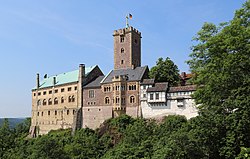
Martin Luther's popularity among the German people and many rulers paid off for him, though. Frederick III, the Elector of Saxony, coordinated a fake highway attack with Luther in order to secret him away to a safe place at Wartburg Castle.[69] At Wartburg, Luther could write more religious works with impunity. He translated the New Testament into German and distributed more religious treatises which began to lay the foundation for Protestantism as a whole.[70] In 1525, he helped solidify his writings into the basis for a new church and Christian denomination: Lutheranism.[71]
With the Reformation giving them a chance to further oppose the emperor's authority, many of the Electors chose to embrace it, most notably Saxony, Brandenburg, and the Palatinate. It was less about theology and more about pissing off the emperor.
Religious wars[edit]
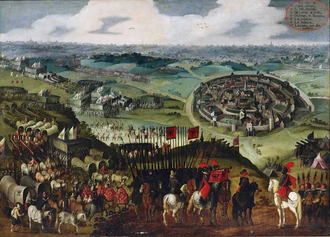
The Electors and their other Protestant allies formed a military pact called the Schmalkaldic League in an attempt to protect themselves against an increasingly furious emperor.[72] The League had major military power, but it was hampered by the competing interests and personalities of its many leaders. It grew without opposition while the emperor was busy fighting France, but the emperor eventually returned to defeat it in a short war in 1546.[73] As you can expect with religious matters, things were far, far, far, far, far from over.
The League quickly reformed and rose up again in the Second Schmalkaldic War in 1552, this time on the winning side.[74] The Holy Roman Diet convened in 1555 in response and passed the Peace of Augsburg, which allowed for German princes to choose Catholicism or Lutheranism as their faith in the hopes of everyone getting the fuck along.[75] Unfortunately, people couldn't just get the fuck along.
The Peace of Augsburg almost immediately started to unravel. The most significant factor in this was the unprecedented phenomenon of Catholic prince-bishops converting to Protestantism but refusing to give up their land. When the prince-bishop of Cologne tried to do that in 1583, Catholic powers attacked him in order to keep Cologne in Catholic hands.[76] During the fighting, the Catholic forces surrounded the city of Neuss and totally destroyed it with a combination of artillery fire, destructive house-to-house fighting, and plundering, actions which killed an estimated 4,000 civilians.[77] The Catholic victory in the Cologne War totally destroyed the brief period of religious peace in the empire.
In response to further inter-religious violence, many of the Protestant powers led by the Palatinate and Brandenburg formed the Protestant Union in 1608, an even larger coalition of both Lutheran and Calvinist states to protect against the Catholics.[78] In 1609, it intervened in the War of the Jülich Succession, pitting them against both the emperor and Spain.[79] Another bloody round of fighting later, and the religious question still wasn't any closer to resolution.
The Thirty Years War[edit]

As the decades went on from the collapse of the Augsburg agreement, total religious war became inevitable. Religious tensions between Catholicism and the various Protestant faiths embroiled not only the empire but other states around Europe into endless conflicts. France endured the French Wars of Religion![]() against the Huguenots, decades of conflict and mass murder which cost the lives of three million people.[80] Spain and the Netherlands duked it out over Dutch independence, a conflict aggravated by their religious differences and also escalating into the total destruction of multiple cities. England was also about to fall into the English Civil War, which would draw in the rest of the British Isles.
against the Huguenots, decades of conflict and mass murder which cost the lives of three million people.[80] Spain and the Netherlands duked it out over Dutch independence, a conflict aggravated by their religious differences and also escalating into the total destruction of multiple cities. England was also about to fall into the English Civil War, which would draw in the rest of the British Isles.
In this atmosphere of religious crisis, Ferdinand II became the new Holy Roman Emperor, and he was widely known as a zealous Catholic and an oppressor of Protestants.[81] Tensions exploded in 1618 when Ferdinand II sent some Hapsburg goons into Bohemia to close down Protestant churches, inciting the Czechs to retaliate by putting the officials on a show trial and then tossing them out of a church window.[82] Bohemia then rose up against the Hapsburg crown, although they were quickly smashed by the Austrian armies.[83]
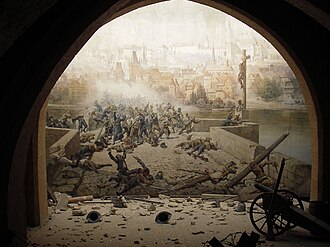
At this point, everybody else started jumping in. The Protestant states in northern Germany felt they had to join the revolt, but they were smashed by a Spanish army coming over from the Low Countries.[84] Denmark also tried to intervene on behalf of the Protestants, but they too fell to defeat. Emboldened by this military success, Ferdinand issued the Edict of Restitution, which effectively confiscated most Protestant-held land in the empire.[85] The edict undermined the Catholic faction's success and ensured permanent opposition to them.
All throughout this fighting, the mercenary armies of the various belligerents constantly committed hideous crimes by pillaging everywhere they could and murdering anyone who resisted.[86][87] The armies moving back and forth resulted in huge swathes of Germany being totally razed.
Eventually, Sweden intervened under its king Gustavus Adolphus, who sincerely wanted to protect the Protestants but also wanted to seize some Baltic German land for himself.[88] The Swedes and their allies were also bolstered by French funds. France, despite being a Catholic nation, hated the Hapsburg powers and hoped to undermine their power. After Gustavus' death, France joined the war directly and fought Spain and Austria for more than ten years before both sides finally agreed to a peace of exhaustion.
In 1648, all parties signed the various treaties composing the Peace of Westphalia, guaranteeing limited religious freedoms for religious minorities in the empire, curbing the emperor's power even further, and allowing the various princes of the empire to choose their own state religions.[89]
This war basically killed the Holy Roman Empire, as the states were more autonomous than ever, and its economy was so ravaged that it wouldn't recover until well after its official dissolution. The war ultimately killed somewhere between five and ten million people through warfare, murder, disease, and famine.[90] What a trainwreck.
Aftermath of the religious wars[edit]

The Thirty Years War and its various preceding wars of religion left the Holy Roman Empire in ruins. Food shortages and marauding soldiers had created a total breakdown in social order, with peasants banding together for protection, food shortages and famines hitting everywhere, and rodent and disease outbreaks becoming uncontrollable.[91] Widespread despair led to a huge increase in witch hunts, as people hoped to scapegoat others for the empire's problems and the horrible state of their lives.[92]
The good thing was that the Peace of Westphalia successfully defused the religious time bomb by removing the right of the Holy Roman Emperor to meddle in the personal faiths of his vassals, and the memories of the war made sure that lesson stuck.[93] The haunting memories of the war also made it harder in the future for rulers to get their populations amped for war against other Christians; they would instead have to rely on personal loyalties and eventually nationalism.
Finally, the consequence that would be most apparent in the empire's future foreign policy, the war and the peace granted huge autonomy to the various states, allowing them to raise and train professional armies and even defeat the emperor himself.
Hapsburg-Lorraine dynasty[edit]

Prussia and the Austrian Succession[edit]
A small German state centered around Berlin called the Kingdom of Prussia, formerly the Electorate of Brandenburg, used its newfound autonomy to invite religious refugees from other parts of Europe and start raising a huge professional army.[94] Thanks to the efforts of its ruler Frederick William, Prussia became a state that was uncommonly centered around its army; even in peacetime roughly three-quarters of its spending went into the army.[95]
In 1740, the Holy Roman Empire was shaken up when the Habsburg crown went to a woman, Maria Theresa. This was originally super illegal under German traditional law, but when Maria Theresa was born, the then-reigning emperor enacted the "Pragmatic Sanction" to ensure that she could inherit the empire.[96] This was still quite unpopular among certain princes, who saw an opportunity to undermine the Hapsburg hold on power. Among them were France (of course), Bavaria, and Prussia.
Immediately upon Maria Theresa's accession to the throne, the anti-Habsburg forces attacked on the basis that the Elector of Bavaria should have the throne instead. Prussia, under its ruler Frederick "the Great", hit hard and fast and stole the large and rich province of Silesia from Austria, then quit the war early.[97] Without Prussia's participation, the war ended in a stalemate. Maria Theresa remained effectively in charge of the empire, but the actual title went to her husband Francis I of Lorraine, who served as a widely-recognized puppet emperor to his wife.[98] Feminism, sorta?
The involvement of the House of Lorraine in the empire's succession led to the creation of the House of Habsburg-Lorraine, which ruled over the empire during its final death throes.
Cold war inside the empire[edit]

“”But never forget: better a mediocre peace than a glorious war.
|
| —Maria Theresa in 1778 to her son Joseph II.[99] |
Despite its small size and being left to face off against Austria, France, and Russia almost alone during the Seven Years' War, Prussia kept all of its territorial gains and became acknowledged as a European great power.[100] Prussia's ruler, Frederick the Great, then instigated the first partition of Poland, where Prussia and its temporary allies in imperialism, Russia and Austria, ripped away huge chunks of territory from the Polish rump state.[101]
Both Frederick and Maria Theresa embraced the Enlightenment by modernizing their state bureaucracies, secularizing their states, and allowed religious exiles from elsewhere in Europe like Jews and Calvinists to settle in their countries.[101] Despite their similarities, Prussia and Austria hated each other and diplomatically grappled for influence over the various smaller states of the empire. This conflict turned hot again in 1778 when Hapsburg Austria tried to place a member of the dynasty onto the contested throne of Bavaria in order to expand its domains. Frederick immediately attacked, starting the bloody War of the Bavarian Succession, which was less a military conflict than it was a war in which both sides had their armies stand around to die of dysentery.[99]
The two powers also often got involved in other European conflicts on opposing sides. The Holy Roman Empire had ceased to be an empire and was now a diplomatic battleground similar to Europe during the Cold War.
French Revolution[edit]
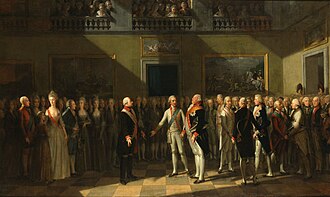
The Enlightenment had been powerful in Germany, so the initial stages of the French Revolution were well-received by German intellectuals and the educated class.[102] After all, they were right in that the empire had no place existing in a modern post-Westphalia world, since its legitimacy still rested on empty religious claims and its legal structure at this point existed only on paper.[103] The empire was hollower than a cheap chocolate bunny.
On the other hand, the royal courts in Berlin and Vienna feared the revolution's promise to spread anti-monarchal ideals throughout Europe, and much of the German educated class were alienated when the Jacobin regime executed France's king. The smaller states also hoped to see the empire continue because its legal structures were their best chance at maintaining their independence against larger imperialists like Austria, Prussia, or other outside powers.[104]
For the Hapsburgs, the Revolution was also personal, since France's queen Marie Antoinette was the Holy Roman Emperor's sister.[105] In a rare show of unity, Frederick William II of Prussia and Habsburg Holy Roman Emperor Leopold II issued the Declaration of Pillnitz in 1791 in support of the French monarchy.[106] The French revolutionary government interpreted that as a threat and preemptively declared war on both parties. The rest of the empire then rallied around them, if only to prove that the conservative imperial values weren't dead yet.[107]
In the hopes of threatening the revolutionary government into submission, Prussia and Austria promised to raze Paris and slaughter its inhabitants if anything bad happened to the king or Marie Antoinette.[108] The problem was that this promise came right after the royal family was guillotined, and the fear that the threat caused helped motivate French armies into victory over the empire. France annexed parts of the empire after the war, and in response Leopold II reorganized the empire to compensate those states that had lost land, mostly at the expense of the remaining ecclesiastical territories.[109]
Napoleon kills the empire[edit]
.jpg)
When Napoleon Bonaparte declared himself the Emperor of the French, the Hapsburgs were furious since the Holy Roman Empire was supposed to be the only Catholic empire, and they also feared that other monarchs such as George III of the British Empire might declare themselves emperor too.[110] Basically, Leopold wanted to feel special.
Leopold's successor Francis II also wanted to feel special, so he decided to declare himself the Emperor of Austria, effectively making himself double emperor and ensuring that he was still technically Napoleon's superior. Napoleon shrugged it off as not too big a deal, and the only major opposition to that idea came from Sweden of all places.[111] But who cares about them?
These tensions over titles contributed to Austria's entry into the War of the Third Coalition in 1805. Unfortunately for Francis, Prussia chose to remain neutral, meaning that much of the empire's military strength was sidelined.[112] Austria, meanwhile, had been hastily reorganizing its army in response to its earlier defeats, and the sudden outbreak of war later in 1805 caught them with their pants around their ankles.[113] The imperial state of Bavaria also aligned with Napoleon, and they spent the early phase of the war pushing Austria's shit in throughout southern Germany.[114] The final battle came on Czech soil in December 1805, where Napoleon smashed a much larger joint Austrian-Russian force with relative ease.[115]
The crushing defeat of the empire forced Austria to capitulate. The Peace of Pressburg completed the gradual collapse of the Holy Roman Empire by reorganizing it into a series of Napoleonic puppet states.[116] The empire, which had been torn apart by religion and feudalism, was now torn apart by an outside conqueror. Napoleon then grouped his subject states into the so-called "Confederation of the Rhine" and then had them all jointly secede from the Holy Roman Empire.[117] With Prussia not too keen on defending its old rival's power, the Holy Roman Empire was thus Austria and nobody else. Francis II realized the inevitable and abolished the Holy Roman Empire.
Legacy[edit]
Despite its fractious and constantly war-torn nature, Germans for a long time afterwards came to view the empire as the good old days. Institutions like the German Confederation![]() were abortive attempts at reviving the empire, and the German Empire was seen as the redemption of the old empire's dissolution. Nazi Germany also tried to invoke the empire by proclaiming that its "Reich" would last 1,000 years just like the HRE did.[118] Luckily, that didn't happen.
were abortive attempts at reviving the empire, and the German Empire was seen as the redemption of the old empire's dissolution. Nazi Germany also tried to invoke the empire by proclaiming that its "Reich" would last 1,000 years just like the HRE did.[118] Luckily, that didn't happen.
The empire is now totally erased, as the only member states that still exist as monarchies are Luxembourg and Liechtenstein. Germany and Austria, meanwhile, have changed significantly and now hope to chart a new future as secular democratic republics.
External links[edit]
- How did the Holy Roman Empire Work? a short video by History Matters on Youtube.
- Why Was the Holy Roman Empire Dissolved? a short video by History Matters on Youtube.
References[edit]
- ↑ Oxford Essential Quotations: Voltaire 1694–1778, French writer and philosopher edited by Susan Ratcliffe (2018) Oxford University Press. ISBN 9780191866692.
- ↑ See the Wikipedia article on King of the Romans.
- ↑ The Holy Roman Empire. Heraldica.
- ↑ 4.0 4.1 4.2 Prince Elector of the Holy Roman Empire. Holy Roman Empire Association.
- ↑ See the Wikipedia article on Prince-elector.
- ↑ Charlemagne. Wikiquote.
- ↑ Imperial immediacy of the Holy Roman Empire. Holy Roman Empire Association.
- ↑ 8.0 8.1 See the Wikipedia article on Imperial Estate.
- ↑ See the Wikipedia article on Imperial Diet (Holy Roman Empire).
- ↑ 10.0 10.1 Diet. Britannica.
- ↑ 11.0 11.1 The Golden Bull of Charles IV 1356. Fordham University.
- ↑ 12.0 12.1 12.2 Medieval Justice: Cases and Laws in France, England and Germany, 500-1500. By Hunt Janin. Google Books.
- ↑ The Napoleonic Code. History Research Guides by Boston University Students.
- ↑ Seven German cities you never knew were once capitals. The Local.
- ↑ Hakkapeliitta. Wikiquote.
- ↑ Holy Roman Empire. Britannica.
- ↑ 17.0 17.1 Religious Divide in the Holy Roman Empire. Lumen Learning.
- ↑ Innes, Matthew (24 April 2000). State and Society in the Early Middle Ages: The Middle Rhine Valley, 400–1000. pp. 167–70. ISBN 9781139425582.
- ↑ See the Wikipedia article on Merovingian dynasty.
- ↑ Kohn, George C. (2006). Dictionary of Wars. pp. 113–14. ISBN 9781438129167.
- ↑ 21.0 21.1 Charlemagne: Emperor Of The Romans. Britannica.
- ↑ See the Wikipedia article on Partible inheritance.
- ↑ See the Wikipedia article on Treaty of Verdun.
- ↑ Cantor, Norman F. (1994). The Civilization of the Middle Ages. Harper Perennial. ISBN 978-0-06-092553-6. 214–15
- ↑ 25.0 25.1 Otto the Great is crowned Emperor of the Romans. History Today.
- ↑ See the Wikipedia article on Pope John XII.
- ↑ Gregory V. Britannica.
- ↑ Gregory V, Pope. Encyclopedia.
- ↑ Salian Dynasty. Britannica.
- ↑ See the Wikipedia article on Henry IV, Holy Roman Emperor.
- ↑ Barraclough, Geoffrey (1984). The Origins of Modern Germany. New York: W. W. Norton & Co. Inc. ISBN 978-0-393-30153-3. p.101–134
- ↑ 32.0 32.1 32.2 32.3 32.4 The Investiture Controversy. Lumen Learning.
- ↑ Barraclough, Geoffrey (1984). The Origins of Modern Germany. New York: W. W. Norton & Co. Inc. ISBN 978-0-393-30153-3. p.109
- ↑ See the Wikipedia article on Road to Canossa.
- ↑ See the Wikipedia article on Great Saxon Revolt.
- ↑ See the Wikipedia article on Battle on the Elster.
- ↑ See the Wikipedia article on Antipope Clement III.
- ↑ Freed, John (2016). Frederick Barbarossa: The Prince and the Myth. New Haven, CT: Yale University Press. ISBN 978-0-300-122763. p. 43–45.
- ↑ Freed, John (2016). Frederick Barbarossa: The Prince and the Myth. New Haven, CT: Yale University Press. ISBN 978-0-300-122763. p. 51–53
- ↑ See the Wikipedia article on Battle of Dorylaeum (1147).
- ↑ Nicolle, David (2009). The Second Crusade 1148: Disaster outside Damascus. London: Osprey. ISBN 978-1-84603-354-4.
- ↑ See the Wikipedia article on Siege of Damascus (1148).
- ↑ See the Wikipedia article on Treaty of Constance (1153).
- ↑ 44.0 44.1 Frederick I Barbarossa: A Megalomaniac Roman Emperor On a Crusade for Power. Ancient Origins.
- ↑ Comyn, Robert (1851). History of the Western Empire, from its Restoration by Charlemagne to the Accession of Charles V. I. p. 245.
- ↑ See the Wikipedia article on Battle of Legnano.
- ↑ 47.0 47.1 Holy Roman Empire: The Emperor’s Loss of Centralized Authority. Lumen Learning.
- ↑ Loud, G. A. (2010). The Crusade of Frederick Barbarossa: The History of the Expedition of the Emperor Frederick and Related Texts. Farnham, Surrey: Ashgate Publishing. ISBN 9780754665755. p. 19
- ↑ See the Wikipedia article on Battle of Iconium (1190).
- ↑ Loud, G. A. (2010). The Crusade of Frederick Barbarossa: The History of the Expedition of the Emperor Frederick and Related Texts. Farnham, Surrey: Ashgate Publishing. ISBN 9780754665755. p. 64.
- ↑ See the Wikipedia article on German throne dispute.
- ↑ 52.0 52.1 52.2 52.3 Holy Roman Emperor Otto IV - 1209-1215. Holy Roman Empire Association.
- ↑ 53.0 53.1 53.2 53.3 Frederick II, Holy Roman Emperor. Britannica.
- ↑ Fifth Crusade. Britannica.
- ↑ The Crusade of Frederick II. Britannica.
- ↑ The Sixth Crusade History Learning
- ↑ Stanley William Rothstein (1995). Class, Culture, and Race in American Schools: A Handbook. Greenwood Publishing Group. pp. 9–. ISBN 978-0-313-29102-9.
- ↑ A medieval European union: why the Hanseatic League still matters. History Extra.
- ↑ Kohn, George Childs (1999). Dictionary of Wars. Routledge. p. 145. ISBN 9781135954949
- ↑ Golden Bull of Emperor Charles IV. Britannica.
- ↑ Western Schism. Britannica.
- ↑ Frederick III. Britannica.
- ↑ See the Wikipedia article on Maximilian I, Holy Roman Emperor.
- ↑ See the Wikipedia article on The empire on which the sun never sets § Habsburg Empire of Charles V.
- ↑ See the Wikipedia article on Franco-Ottoman alliance.
- ↑ See the Wikipedia article on Ninety-five Theses.
- ↑ Discontent with the Roman Catholic Church. Lumen Learning.
- ↑ See the Wikipedia article on Diet of Worms § Edict of Worms.
- ↑ See the Wikipedia article on Frederick III, Elector of Saxony.
- ↑ Wartburg Castle. Atlas Obscura.
- ↑ Schroeder, Steven (2000). Between Freedom and Necessity: An Essay on the Place of Value. Rodopi. p. 104. ISBN 978-90-420-1302-5.
- ↑ Schmalkaldic League. Britannica.
- ↑ See the Wikipedia article on Schmalkaldic War.
- ↑ See the Wikipedia article on Second Schmalkaldic War.
- ↑ Peace of Augsburg. Britannica.
- ↑ See the Wikipedia article on Cologne War.
- ↑ See the Wikipedia article on Destruction of Neuss.
- ↑ See the Wikipedia article on Protestant Union.
- ↑ See the Wikipedia article on War of the Jülich Succession.
- ↑ The French Religious Wars 1562-1598 (Essential Histories) Robert Knecht.
- ↑ Persecutor of the Protestants: Ferdinand II World of the Habsburgs. ND.
- ↑ The Defenestration of Prague Britannica ND.
- ↑ Bohemia Britannica. ND.
- ↑ Wedgwood, CV (1938). The Thirty Years War (2005 ed.). New York Review of Books. ISBN 978-1590171462. p. 137
- ↑ See the Wikipedia article on Edict of Restitution.
- ↑ The Thirty Years' War
- ↑ Military developments in the Thirty Years' War C N Trueman "Military Developments In The Thirty Years' War" historylearningsite.co.uk. The History Learning Site, 25 Mar 2015.
- ↑ Wedgwood, CV (1938). The Thirty Years War (2005 ed.). New York Review of Books. ISBN 978-1590171462. p. 385-386
- ↑ Westphalia, Peace of Bardo Fassbender, Oxford Public International Law, Feb. 2011 (section B10)
- ↑ White, Matthew. "The Thirty Years' War (1618-48)". Necrometrics. ND.
- ↑ Wilson, P. (2009). Europe's Tragedy: A History of the Thirty Years War. London: Penguin. p. 4. ISBN 978-0-7139-9592-3. p. 784.
- ↑ White, Matthew (2012). The Great Big Book of Horrible Things. W.W. Norton & Co. ISBN 978-0393081923. p. 220
- ↑ Europe’s apocalypse: the Thirty Years’ War. History Extra.
- ↑ Rise of Prussia. Heritage History.
- ↑ The Prussian Military State.
- ↑ See the Wikipedia article on Pragmatic Sanction of 1713.
- ↑ Frederick the Great. Heritage History.
- ↑ See the Wikipedia article on Francis I, Holy Roman Emperor.
- ↑ 99.0 99.1 A war over plums and potatoes. The World of the Hapsburgs.
- ↑ Russell F. Weigley (2004). The Age of Battles: The Quest for Decisive Warfare from Breitenfeld to Waterloo. Indiana University Press. pp. 192–. ISBN 0-253-21707-5.
- ↑ 101.0 101.1 Austria and Prussia. German Culture.
- ↑ Sheehan, James J. (1989). German History: 1770–1866. pp. 75, 207–291, 291–323, 324–371, 802–820.
- ↑ Blanning, Tim (2012). "The Holy Roman Empire of the German Nation past and present". Historical Research. 85 (227): 57–70. doi:10.1111/j.1468-2281.2011.00579.x.
- ↑ Wilson, Peter H. (2009). "The Meaning of Empire in Central Europe around 1800". In Forrest, Alan; Wilson, Peter H. (eds.). The Bee and the Eagle: Napoleonic France and the End of the Holy Roman Empire, 1806. Palgrave Macmillan. ISBN 978-0-230-00893-9. p. 25.
- ↑ See the Wikipedia article on Marie Antoinette.
- ↑ See the Wikipedia article on Declaration of Pillnitz.
- ↑ Wilson, Peter H. (2006). "Bolstering the Prestige of the Habsburgs: The End of the Holy Roman Empire in 1806". The International History Review. 28 (4): 709–736. doi:10.1080/07075332.2006.9641109. S2CID 154316830.
- ↑ War of the First Coalition in 1790s France. ThoughtCo.
- ↑ See the Wikipedia article on Reichsdeputationshauptschluss.
- ↑ Wilson, Peter H. (2009). "The Meaning of Empire in Central Europe around 1800". In Forrest, Alan; Wilson, Peter H. (eds.). The Bee and the Eagle: Napoleonic France and the End of the Holy Roman Empire, 1806. Palgrave Macmillan. ISBN 978-0-230-00893-9. p. 26.
- ↑ Wilson, Peter H. (2006). "Bolstering the Prestige of the Habsburgs: The End of the Holy Roman Empire in 1806". The International History Review. 28 (4): 709–736. doi:10.1080/07075332.2006.9641109. S2CID 154316830. p. 726
- ↑ Prussia – the Third Coalition and the Battle of Austerlitz. Foundation Napoleon.
- ↑ Fisher, Todd; Fremont-Barnes, Gregory (2004). The Napoleonic Wars: The Rise and Fall of an Empire. Oxford: Osprey Publishing. ISBN 1-84176-831-6. p. 32
- ↑ See the Wikipedia article on Ulm campaign.
- ↑ See the Wikipedia article on Battle of Austerlitz.
- ↑ See the Wikipedia article on Peace of Pressburg (1805).
- ↑ The End of the Holy Roman Empire. History Today.
- ↑ In a nutshell: the Holy Roman Empire. History Revealed.
Categories: [Catholicism] [Christian fundamentalism] [Empires] [European history] [Germany] [History] [Historical countries] [Medieval history] [Religious discrimination]
↧ Download as ZWI file | Last modified: 11/05/2025 11:02:44 | 180 views
☰ Source: https://rationalwiki.org/wiki/Holy_Roman_Empire | License: CC BY-SA 3.0
 KSF
KSF